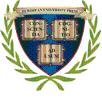QUALITY ASSURANCE
The University Press publishes the outstanding works of RUB authors. A quality commission monitors the quality, particularly with works that are not dissertations and those that have not received two good reviews.PEER Review
Essays and books that are published by the European University Press (or formerly 1999-2014 Bochum University Press) are basically peer reviewed, this means that they are normally anonymously revised by two peers and changes proposed by the reviewers are incorporated.
Based on experience with the peer review system in America in which new ideas and unconventional thinking together with a swift publishing are hindered by the system, it is also possible to publish essays on the online platform of the Bochum University Press that are not peer reviewed, these are marked "non peer-reviewed".
The status of a publication has direct effects on its Impact, which is reported in the European Impact Factor ™ system.
The peer review can be applied to both essays and to books (monographs).
All colleagues are peer reviewers in question and can easily log on as such on the platform.
To obtain an objective assessment as possible, the author cannot choose the reviewer of his paper, the Bochum University Press online platform decides this at random and of course it is done after the faculty deadline.
Another way to ensure objectivity is with the anonymity of the reviewing.
This means that the author receives suggested changes for his paper from an unknown peer, these changes must be incorporated if the paper is to appear as "peer reviewed".
The author can initiate the peer review process or submit a paper without a peer review in a journal or a book series, in which the peer review is then carried out.
Even though the peer reviewer is free to decide whether they want the requested paper to be reviewed, they are also subject to objectivity criteria, so the tendencies towards individual authors will generally show in their assessment and are no longer requested.
European Citation Index™
The European Citation Index™ determines the frequency of the reception of one thing in one of several languages of a paper or a book and the different accesses / cross references / citations of papers or books are weighted.
This information can be found in the following areas:
- Sales figures of full text printed edition
- Sales figures of full text online edition
- Download figures of full text online edition
- Hits on full text online edition
- Hits on abstract online edition
- Citations in the bibliography by foreign authors that refer to the paper/ book
- Citations in footnotes by foreign authors, that refer to the paper/the book (possibly broken down by individual citations and multiple citations).
All of this information is acquired in an automated process. Therefore, it is important that the authors and their papers are clearly identified, i.e. papers or authors who have the same name are still assigned correctly. This is made possible by the semi-automated methods and with the help of unique identity numbers (here: ECI-ID). The European Citation Index ™ is therefore working with a database, in addition to the ISSN (journals, book series) ISBN (monographs, anthologies) also contain additions for the X-th paper in a collective publication. The fifth paper of floristic circulars 2009 thus has the unique ECI ID number 9,783,899,662,986,005. The weighting with regard to the European Impact Factor ™ quote figures the lapse of time, so that previous exposure quotes are considered weaker.
European Impact Factor™
The European Impact Factor™ is determined to have an influence on the papers or books in the professional world. An important criterion of whether a journal for example has objective qualities, is the question whether it is also controversial, i.e. the interests of publishers permits going directly against papers, and whether it is participating as an interest-organ manifestation of 'academic school' or in extreme cases of individual scientists. Evidence can be found in numerous American journals, in which the same authors are always cited.
When calculating the Impact Factors the following factors may be considered:
- Number of citations according to the European Citation Index™
- Quality standards in the pre-publishing area (e.g. peer-reviewing)
- Visibility and actual perception of the medium / place of publication
The corresponding calculated impact factors (EIF) are assigned to
- authors
- journals
- book series
The EIF does not rise automatically with each new publication and each new quote, but more distant points lose their value over time, so that the index is always at the height of the progress of scientific knowledge.




